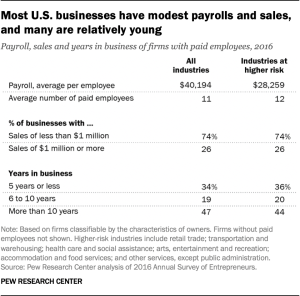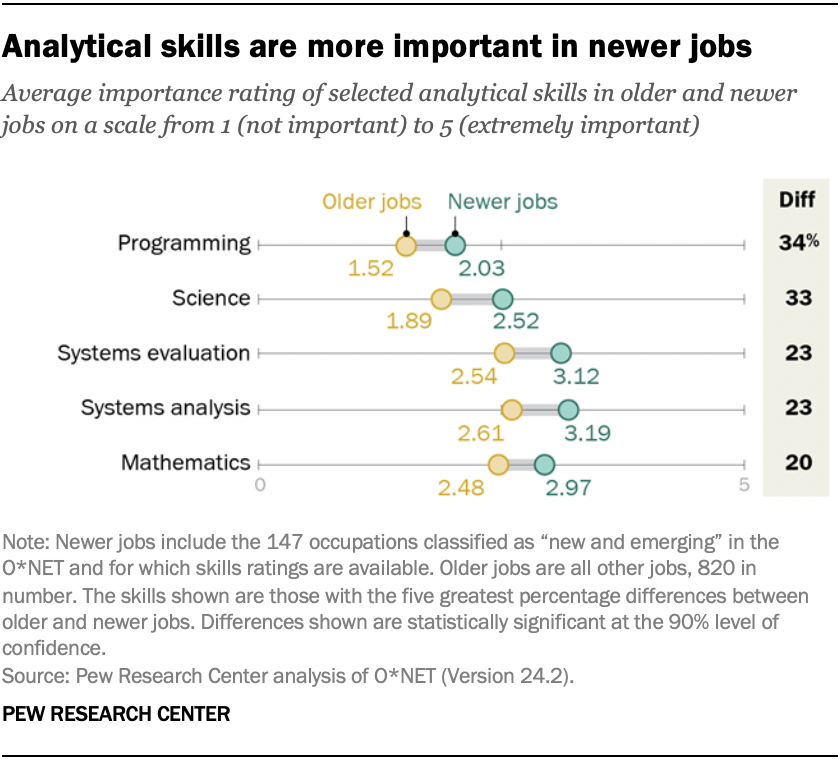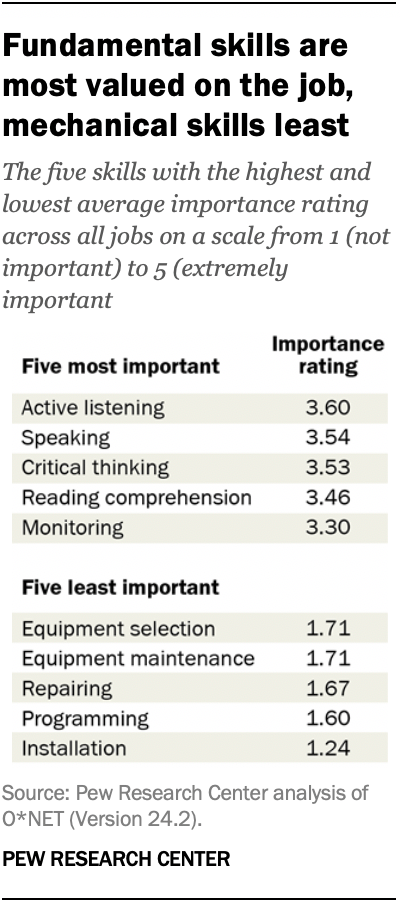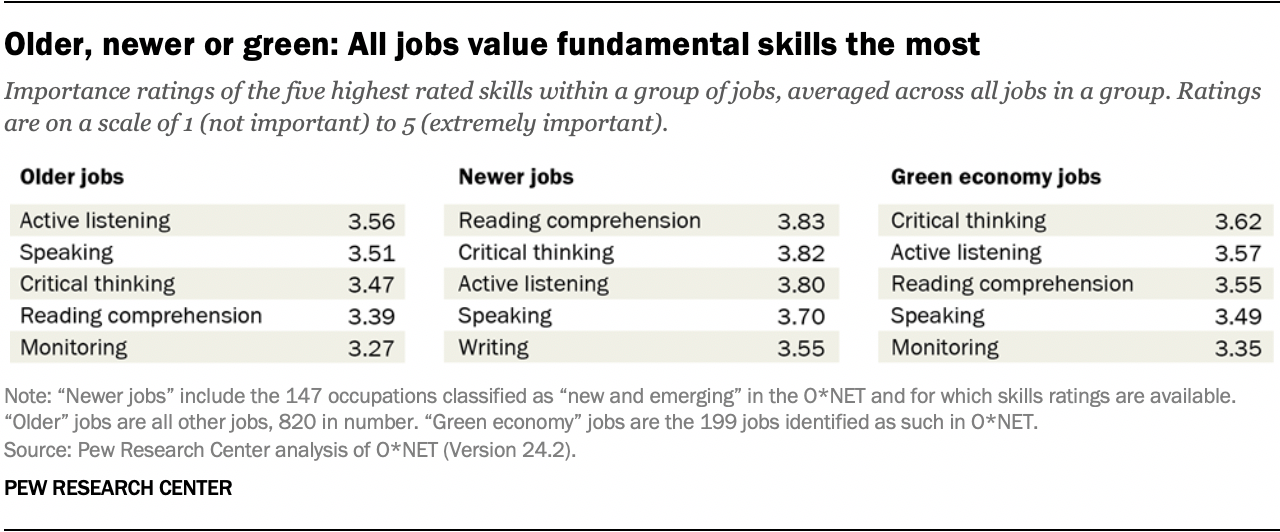

In a changing U.S. labor market, new and emerging occupations – including those that are linked to a green economy or the adoption of newer technologies – are raising the importance of analytical skills, such as science, mathematics and programming, according to a new Pew Research Center analysis of federal government job-skills data.
New and emerging occupations either represent new lines of work or are newly deserving of their own classification due to rising employment and other factors. Examples of novel jobs include database architects and informatics nurse specialists. Among newly classified occupations are biostatisticians and intelligence analysts.
But the green economy is also raising the demand for some mechanical skills, such as equipment maintenance and repairing, which have diminished in importance in recent decades as the number of U.S. manufacturing jobs declines. With its emphasis on the environment and the sustainable use of resources, the green economy has stimulated employment in existing engineering and production jobs, ranging from industrial engineers to electricians, which often call for mechanical proficiency.
How we did this
The American workplace has seen a rising need for high-skill workers in recent decades, driven in part by the emergence of new occupations in today’s economy. This analysis examines how the need for different skills varies across older, newer and green economy jobs.
The analysis is based on job skills data from the U.S. Department of Labor, Employment and Training Administration’s Occupational Information Network (O*NET), specifically Version 24.2, released February 2020. O*NET analysts rate the importance of 35 skills related to job performance in 967 occupations. For the purposes of some of this analysis, we grouped these into five major families of job skills: social, fundamental, analytical, managerial and mechanical. Occupational employment and wage data are from the U.S. Bureau of Labor Statistics, Occupational Employment Statistics program. For more information about the analysis, see the methodology section.
Amid these changes, the most valued skills in the American workplace fall into the category of “fundamental skills” – active listening, speaking, critical thinking and reading comprehension. The skill that is currently most in demand among employers is active listening, or the ability to give full attention, take the time to understand, ask questions and not interrupt at inopportune times.

The most significant difference between newer and older occupations is in the importance for analytical skills. Several newer occupations, such as web administrators and data warehousing specialists, have a great need for programming skills. As a result, the average importance rating for programming skills in newer occupations is 34% higher than the average rating in older occupations, 2.03 vs. 1.52 – among the biggest contrasts between the two groups of occupations, according to our analysis of data from the government’s Occupational Information Network (O*NET).
Defining job skills
The U.S. Department of Labor, Employment and Training Administration’s Occupational Information Network (O*NET) provides ratings on the importance of 35 detailed job skills. These skills, grouped into five major families of job skills, are as follows:
Social skills – instructing, service orientation, monitoring, social perceptiveness, coordination, negotiation, and persuasion
Fundamental skills – critical thinking, writing, speaking, reading comprehension, active listening, active learning, learning strategies, and judgment and decision-making
Analytical skills – science, mathematics, programming, complex problem solving, systems analysis, systems evaluation, operations analysis, and technology design
Managerial skills – management of personnel resources, management of financial resources, management of material resources, and time management
Mechanical skills – troubleshooting, equipment selection, equipment maintenance, repairing, installation, operation monitoring, quality control analysis, and operation and control
The grouping is similar to the O*NET classification of skill categories. In general terms, social skills refer to interpersonal skills, fundamental skills lay the foundation for acquiring other skills, analytical skills capture scientific and technological prowess, managerial skills pertain to the management of people, things and finances, and mechanical skills describe the ability to work with and to control machinery or equipment. See an earlier Pew Research Center report for a more detailed analysis of job skills and the jobs that need them the most (or least).
(O*NET assesses the importance of 35 job skills on a scale of one, not important, to five, extremely important. Among the 967 occupations listed in the O*NET, some 147 are classified as “new and emerging.” See text boxes for details.)
Other newer occupations, such as energy engineers and nanosystems engineers, are more intensive users of scientific expertise, boosting the importance rating for science in newer occupations to an average of 2.52, compared with 1.89 among older occupations. Also, the average importance of systems evaluation, a key skill for supply chain managers, is 23% higher among newer occupations, as is the rating for systems analysis, valuable for logistics engineers.
The need for mathematics, a critical skill in newer occupations such as biostatisticians and financial quantitative analysts, is also on the rise. The average rating of mathematics among newer occupations is 2.97 (“important” on the O*NET scale), compared with 2.48 among older occupations. Other skills in greater demand among newer occupations include writing, reading comprehension and critical thinking.
The green economy needs more analytical and mechanical skills
A key feature of the modern-day economy is the focus on activities devoted to curbing pollution and greenhouse gas emissions, economizing on fossil fuels and using more renewable sources, increasing energy efficiency, and recycling. Collectively labeled the “green economy,” these activities give birth to new lines of work. They also either raise the demand for workers in existing occupations or change the skill requirements of some occupations.

Presently, the O*NET classifies 199 occupations as “green occupations.” Seventy-one of these occupations are classified as “new and emerging” – such as biofuels production managers, solar energy systems engineers and climate change analysts. Like newer occupations overall, green economy occupations that are newer also require greater proficiency in analytical skills. Compared with older occupations, the average importance of programming and science skills is at least 34% higher among newer green economy occupations, and the average importance of mathematics, systems analysis and system evaluation is at least 25% higher.
Some green occupations call for greater proficiency in mechanical skills compared with older occupations. These 64 occupations are not new, and neither have they transformed as a result of the needs of the green economy. However, the demand for workers in these occupations, such as industrial engineers and hydrologists, is on the rise due to the emergence of the green economy.
Older green jobs are significantly more likely to require greater proficiency in the following mechanical skills: repairing, equipment maintenance, operation and control, troubleshooting and equipment selection. Compared with older jobs overall, the average importance of these skills is higher by upwards of 22% in older green jobs that are in increased demand.
Our analysis estimates that the 199 occupations listed as “green occupations” in the O*NET, whether older or newer, employed from 31 million to 34 million workers in 2018. This represents about 21% to 24% of overall U.S. employment of 145 million in 2018. Green occupations also paid better than average in 2018: about $30 per hour compared with $25 per hour across all jobs, roughly 20% more as expressed in 2018 dollars.
Across all jobs, fundamental skills are most in need, mechanical skills the least

Looking across the American workplace overall, the most valued skills are fundamental skills. Among the 35 skills evaluated in the O*NET, the top four are fundamental in nature – active listening, speaking, critical thinking and reading comprehension. Rounding off the list of the top five skills is monitoring, a social skill pertaining to the assessment of performance in order to make improvements.
Active listening had an importance rating of 3.6 in 2020, averaged across all occupations, on a scale of one to five. It was rated “very important” to “extremely important” in 270 occupations, such as mental health counselors, and at least “somewhat important” in all occupations. There is no occupation in 2020 in which active listening is “not important”; it is a ubiquitous skill. A similar combination of high importance ratings and prevalent need propels other fundamental skills to the top of the skills ladder.
The bottom rung of the skills ladder in the labor market features a cluster of mechanical skills, namely equipment selection, equipment maintenance, repairing and installation. These skills may be extremely important in some occupations, but they are not in widespread use. For example, installation is extremely important for solar thermal installers and technicians, but it rates important or higher in only 22 occupations.
Programming, an analytical skill, also appears on the lowest rung. Although it is a higher-order computer skill in demand in newer jobs, it is in limited use in the labor market overall. There are only five occupations, including computer programmers, in which programming rates very important to extremely important in 2020. On the other hand, programming is rated not important in 163 occupations.
In between the five highest and lowest rated skills are a mix of other fundamental skills, social skills, analytical skills, managerial skills and mechanical skills. Social skills cluster near the top of the skills ratings, with six of seven social skills ranked among the 15 most highly rated skills. Most analytical skills rank among the 15 lowest rated skills, on average.
Even as newer and greener occupations prioritize analytical skills and revive the need for mechanical skills in some cases, they share one essential trait with older occupations. Regardless of which group of occupations is examined, active listening, speaking, critical thinking and reading comprehension feature at the top of the list of skills ratings. In other words, preparation in fundamental skills remains the common currency in the workplace.

Methodology
This analysis is based on information from the O*NET 24.2 Database by the U.S. Department of Labor, Employment and Training Administration (USDOL/ETA), released February 2020. Used under the CC BY 4.0 license, O*NET is a trademark of USDOL/ETA.
Among other things, O*NET includes information on 35 specific skills representing attributes of workers related to work performance. Each skill is rated on a scale of one to five measuring its importance to job performance, from not important to extremely important. This analysis focuses on the importance ratings of the 35 job skills in the O*NET data. The ratings are based on information generated by trained job analysts.
Version 24.2 of the O*NET contains importance ratings of skills for 968 occupations (at the eight-digit level of classification). One occupation – mathematical technicians – was dropped because it was last evaluated prior to 2002. The importance ratings for the remaining 967 occupations were developed by analysts on a rolling basis from 2010 to 2019, with about 10% or slightly more occupations rated in most years.
The grouping of occupations into the categories “older,” “newer” and “green” is based on how occupations are classified in the O*NET. Newer jobs are identified as “new and emerging” jobs in the O*NET. Older jobs are all other jobs, i.e. those not classified as “new and emerging.” “Green newer” jobs are green jobs that are also new and emerging. “Green older” jobs are green jobs that are not new but are in increased demand; they are identified as “green increased demand” in the O*NET.
Employment and wage estimates for green jobs are based on the matching of O*NET data to data from the U.S. Bureau of Labor Statistics, Occupational Employment Statistics (OES) program. In some cases, the match is exact. For example, fish and game wardens, a green occupation in increased demand, is uniquely identified in both the O*NET and OES data. In other cases, the matching is imperfect. For example, environmental economists are not uniquely identified in OES data. Their employment and wages are represented by the estimates for economists overall. For this reason, employment and wage estimates for green jobs overall are presented as a range. The lower bound estimate of employment in green occupations – 30.7 million – excludes occupations with imperfect matches, such as environmental economists. The upper bound estimate of employment – 34.5 million – includes these occupations, for example using the employment of economists overall to represent the employment of environmental economists. The average hourly wage in green occupations, depending on whether imperfectly matched occupations are included, ranges from $29.88 to $30.53.
It was not possible to estimate employment and wages for new and emerging jobs overall because of a much lower matching rate between O*NET and OES data.